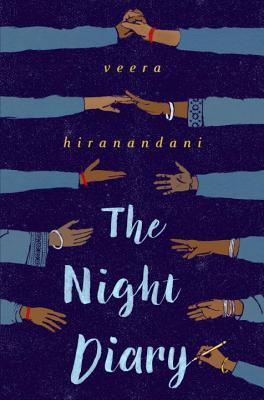 Hiranandani, Veera. The Night Diary
Hiranandani, Veera. The Night DiaryMarch 6th 2018 by Dial Books
E ARC from Edelweiss Plus
On the eve of the Partitioning of India in 1947, Nisha is struggling to understand the implications of the end of British rule on her half-Hindu, half-Muslim family, and writes diary entries to the mother who passed away when she and her twin brother Amil were born in order to process events. Her father, a Hindu doctor, feels that the family must leave their town, which has ended up as an area designated to be Muslim. Long time family cook Kazi is Muslim (as was Nisha's mother), so he will remain behind. Accompanied by their grandmother, the group sets out on foot to walk about 100 miles to the house of the mother's brother. Conditions are horrible, with fighting and violence all around, as well as very little food and water. Amil falls ill, the group is attacked by a man who has lost his family, but they eventually arrive. Nisha is glad to meet her uncle, who looks a bit like pictures of her mother, although he has a cleft palate and does not speak. Once the family is able to settle in Hindu territory, they have a small apartment but are glad to have made it to safety.
Strengths: This is loosely based on some of the author's family's experiences, which makes it more interesting to me. I find the Partition to be my second favorite horrible historical event (the first being the Triangle Shirtwaist Factory fire), and this gave a good overview of the politics, but concentrated on Nisha's experience. There are good descriptions of what it is like to have to walk long distances and survive under horrible circumstances, and the connection with Kazi is sweet.
Weaknesses: I can understand why the diary form was employed, but Nisha's longing for her mother slowed the story down. When losing a mother in child birth was fairly common, I don't know that children really dwelt on their loss this much.
What I really think: There are a few other middle grade novels that touch on the Partition: Kelkar's Ahimsa, Bradbury's A Moment Comes and Outside In, Senzai's Ticket to India and Venkatraman's Climbing the Stairs. While these don't circulate terribly well, I'm always glad when I can get children to read them, so I will probably buy this one.

Stamper, Vesper. What the Night Sings
February 20th 2018 by Knopf Books for Young Readers
Copy provided by the publisher
Gerta lives with her father, a viola player, and her step mother, who is a famous singer. For reasons she doesn't fully understand, she no longer goes to school, but is tutored at home. Eventually, her father stops going to work, and he and Gerta are sent to a concentration camp. The father manages to keep his viola, but it ends up in Gerta's care, which helps her to survive, since she plays in various prison orchestras. Her real love is singing, but the horrors of life in the camps makes it difficult for her to sing. Once the camps are liberated, she meets Lev, a young man who wants to get back to newspaper work, and Micah, who wants to go to Israel to start over. As Gerta starts the slow process of recovering physically and mentally from her travails, she must decide the direction her life will take. While she has a crush on Micah, she eventually realizes that he is not good for her, and marries Lev. The two head to Israel and build a life for themselves.
Strengths: There have been many books written about the concentration camps during the Holocaust, but I can't seem to have enough for my library. I especially appreciated that this dealt with what happened after liberation; few books do.
Weaknesses: I wish this hadn't employed flashbacks quite as much. The history of the Holocaust is difficult enough for students to grasp, and going back and forth in time might confuse them unnecessarily. I also wish the trim size had been more standard; the use of quality paper for the illustrations also makes this very heavy, and gives the book that odd, graphic novel smell that gives me a headache. Students won't notice the smell, but don't like to carry around large books. Therein lies the weirdness that is middle school-- we want quality books for readers, but sometimes it's hard to get children to pick them up for reasons that have nothing to do with the content!
What I really think: The illustrations are very lovely, the writing poetic, and the horrors of the Holocaust fully explained without being too much for a middle school reader to process. A good addition to middle and high school collections.































No comments:
Post a Comment